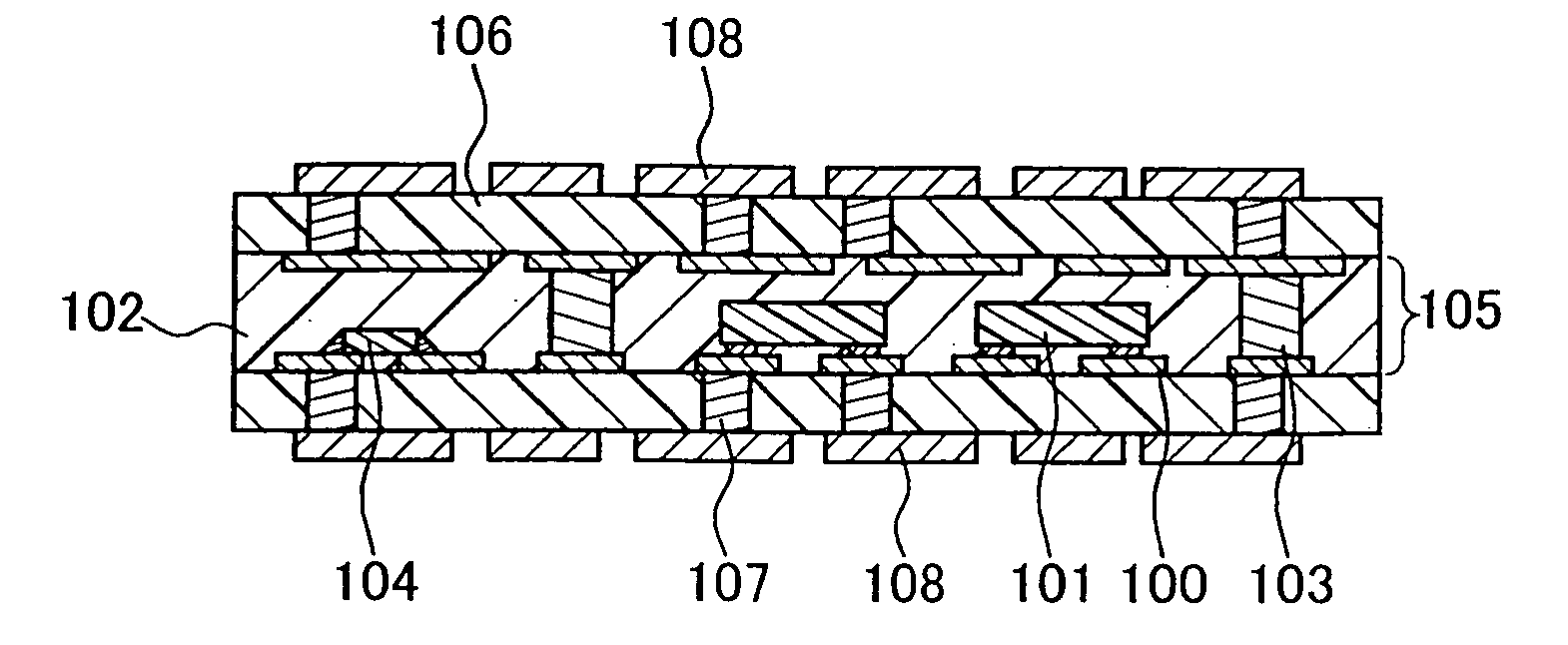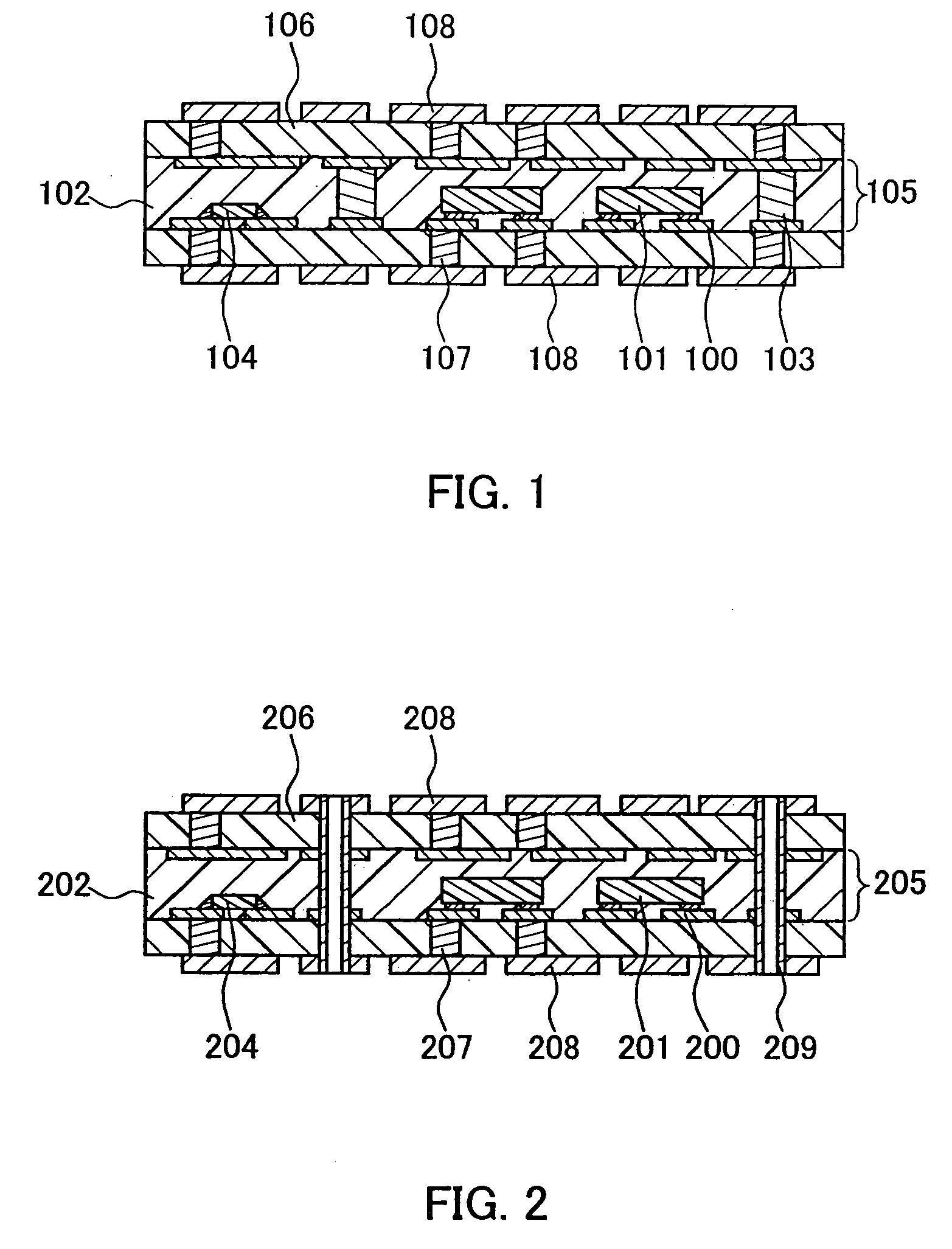Component built-in module and method for producing the same
a module and component technology, applied in the direction of printed circuit parts, printed element electric connection formation, printed circuit non-printed electric components association, etc., can solve the problems of limiting the two-dimensional density of the mounting component, the thermal conductivity is low, and the heat generated by the components is getting more difficult to be released. , to achieve the effect of high-density and small module size, excellent ceramic substrate, and high-performance modul
- Summary
- Abstract
- Description
- Claims
- Application Information
AI Technical Summary
Benefits of technology
Problems solved by technology
Method used
Image
Examples
example 1
[0076] In the production of a component built-in module of the present invention, first, a method for producing a sheet material including an inorganic filler and a thermosetting resin will be explained. The sheet material used in this example is prepared by, at first, mixing an inorganic filler and a liquid thermosetting resin with an agitator. The agitator used in this example operates in such a manner that an inorganic filler, a liquid thermosetting resin, and if necessary, a solvent for adjusting the viscosity of the mixture are placed in a predetermined amount in a container, and the container itself is rotated while stirring the mixture in the container. The mixture obtained should be dispersed sufficiently, even if the mixture has a relatively high viscosity. Tables 1 and 2 show the composition mixed in the sheet material for the component built-in module in this example.
TABLE 1Composition of thermosetting resinthermosetting resin 1thermosetting resin 2contentwt. %Tg(° C.)c...
example 2
[0086] In Example 2, a module containing a semiconductor was made by using a sheet material same as the case 2 in Example 1.
[0087] A 500 μm-thick sheet material 704 in which a through hole was filled with a conductive paste produced under the same conditions as those in Example 1 was prepared (see FIG. 7D). Next, a 70 μm-thick copper foil was formed into a release carrier and further a 9 μm-thick copper was formed on the release carrier by an electrolytic copper-plating method. A wiring pattern was formed by using this release carrier. The release carrier on which the 9 μm-thick copper was formed was chemical-etched by photolithography so as to form a wiring pattern 701 shown in FIG. 7A. A semiconductor and a chip were flip-chip mounted onto the thus produced release carrier with a wiring pattern produced with a solder bump. Furthermore, a film-shaped component was formed on a release carrier having another wiring pattern by a printing method. The film-shaped component 711 is a res...
example 3
[0091] In Example 3, a higher density module is produced by using a core layer in which a semiconductor is contained in the sheet material as in a case 2 of Example 1 and a multilayer ceramic substrate.
[0092] A core layer 805 containing a semiconductor 802 produced under the same conditions as in Example 1 was used (see FIG. 8A). The thickness of the core layer is 300 μm. Next, the multilayer ceramic substrate 809 and the core layer 805 are laminated with an adhesive layer. Moreover, the ceramic multilayer substrate is produced by using a 20 μm-thick green sheet (“MLS-1000” manufactured by Nippon Electric Glass Co., Ltd.) formed of a low temperature firing material mainly including glass and alumina. Namely, a multilayer ceramic substrate was formed as follows: a through hole having a 0.2 mm diameter was formed on the green sheet by a puncher; the through hole was filled with a conductive paste obtained by mixing silver powders having an average particle diameter of 2 μm as a main ...
PUM
| Property | Measurement | Unit |
|---|---|---|
| frequency | aaaaa | aaaaa |
| glass transition temperature | aaaaa | aaaaa |
| glass transition temperature | aaaaa | aaaaa |
Abstract
Description
Claims
Application Information
 Login to View More
Login to View More - R&D
- Intellectual Property
- Life Sciences
- Materials
- Tech Scout
- Unparalleled Data Quality
- Higher Quality Content
- 60% Fewer Hallucinations
Browse by: Latest US Patents, China's latest patents, Technical Efficacy Thesaurus, Application Domain, Technology Topic, Popular Technical Reports.
© 2025 PatSnap. All rights reserved.Legal|Privacy policy|Modern Slavery Act Transparency Statement|Sitemap|About US| Contact US: help@patsnap.com



